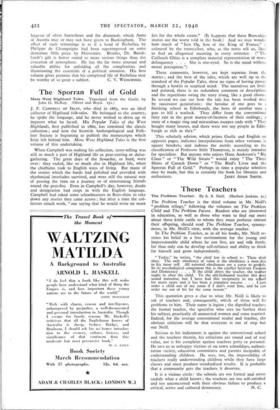The Sporran Full of Gold
More West Highland Tales. Translated from the Gaelic by John G. McKay. (Oliver and Boyd. 25s.) J. F. CAMPBELL OF ISLAY, who died in 1885, was an ideal collector of Highland folk-tales. He belonged to the country, he spoke the language, and he never wished to dress up or improve what he he ird. His Popular Tales of the West Highlands, first published in 186o, has remained the classic collection ; and now the Scottish Anthropological and Folk- lore Society is beginning to publish the manuscripts which Islay left behind him. More West Highland Tales is the first volume of this undertaking.
When Campbell was making his collection, story-telling was still as much a part of Highland life as peat-cutting or dulse- gathering. The great days of the Senachie, or bard, were over : they ended, like so much else in Highland life, when the chieftains took to English ways of living. But many of the stories which the bards had polished and provided with rhythmical interludes survived, and were still the natural way of passing the time on a journey or of entertaining friends round the peat-fire. Even in Campbell's day, however, doubt and denigration had crept in with the English language. Campbell had asked some schoolmasters in Ross-shire to take down any stories they came across ; but after a time the col- lectors struck work, " one saying that he would write no more lies for the whole estate." (It happens that these Ross-shire stories are the worst told in the book.) And we may wonder how much of " Iain Og, Son of the King of France," i, coloured by the transcriber, who, as the notes tell us, liked to find an allegorical meaning in every sentence. (" The Cailleach Ghlas is a complete material representation of moral delinquency . . . She is one-eyed. So is the mind without moral perception.") These comments, however, are kept separate from th, stories ; and the best of the tales, which are well up to the standard of the Popular Tales, show no signs of having passed through a hostile or sceptical mind. The narratives are lively and pointed, there is no redundant comment or description, and the repetitions swing the story along, like a good chorus. In several we can see how the tale has been worked over by successive generations : the heroine of one goes to a finishing school in Edinburgh, the hero of another uses a gun to kill a warlock. They differ from the conventional fairy tale in the great matter-of-factness of their endings ; a story of a magic ring and miraculous escapes ends with " They bought many houses, and there were not any people in Edin- burgh as rich as they."
This scholarly edition, which prints Gaelic and English on opposite pages, indicates interpolations from other versions in square brackets, and indexes the motifs according to the classification of Professor Stith Thompson, is mainly intended for specialists. But anyone who enjoys Hans Andersen's " Big Claus " or " The Wild Swans " would enjoy " The Three Shirts of Canach Down " or " The Bird's Liver and the Sporran Full of Gold." Perhaps in time a popular selection may be made, but this is certainly the book for libraries and






































 Previous page
Previous page